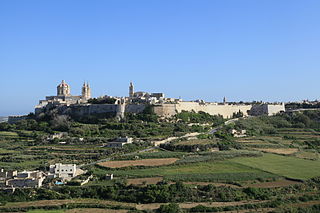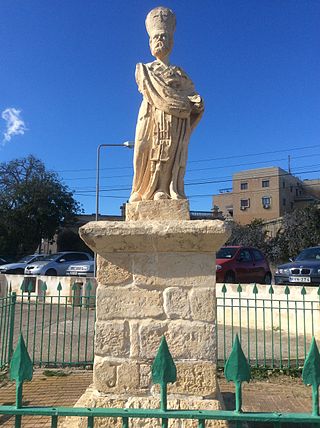
Mdina, also known by its Italian-language titles Città Vecchia and Città Notabile, is a fortified city in the Northern Region of Malta which served as the island's capital from antiquity to the medieval period. The city is still confined within its walls, and has a population of 250, but it is contiguous with the town of Rabat, which takes its name from the Arabic word for suburb, and has a population of over 11,000.

Gudja is a village in the Southern Region of Malta, with a population of 3,148 as of March 2017. The village is located on high grounds, south of Valletta. It is administered by the Gudja Local Council. A number of schools, clubs, public gardens and recreations places are found around the village.

Mtarfa is a small town in the Northern Region of Malta, with a population of 2,572 as of March 2014. It was considered to be a suburb of Rabat until 2000, when it became a separate local council.

Maltese architecture has its origins in prehistory, and some of the oldest free-standing structures on Earth – a series of megalithic temples – can be found on Malta. The islands were colonized by the Phoenicians and later the Romans, who established the cities of Melite and Gaulos. Although these were substantial settlements and are known to have had numerous temples, churches and palaces, few remains have survived apart from some architectural fragments.
The decade of the 1610s in archaeology involved some significant events, some of which are described here.
The decade of the 1710s in archaeology involved some significant events.
The decade of the 1740s in archaeology involved some significant events.

Burmarrad is a hamlet in St. Paul's Bay, Malta. The main heritage site is the San Pawl Milqi zone, where there is a chapel dedicated to St. Paul, built on the remains of a Roman temple dedicated to Apollo, and tradition says to be the remains of the home of St. Publius. The Parish Church dedicated to the Immaculate Hearth Of Mary was built in 1964. The village feast is celebrated on the last Sunday of June. Burmarrad forms part of the Saint Paul's Bay local council

Antonio Annetto Caruana, also known as A. A. Caruana, was a Maltese archaeologist and author.

The Metropolitan Cathedral of Saint Paul, commonly known as St Paul's Cathedral or the Mdina Cathedral, is a Catholic cathedral in Mdina, Malta, dedicated to St. Paul the Apostle. The cathedral was founded in the 12th century, and according to tradition it stands on the site of where Roman governor Publius met St. Paul following his shipwreck on Malta. The original cathedral was severely damaged in the 1693 Sicily earthquake, so it was dismantled and rebuilt in the Baroque style to a design of the Maltese architect Lorenzo Gafà between 1696 and 1705. The cathedral is regarded as Gafà's masterpiece.

The Domus Romana, stylized as the Domvs Romana, is a ruined Roman-era house located on the boundary between Mdina and Rabat, Malta. It was built in the 1st century BC as an aristocratic town house (domus) within the Roman city of Melite. In the 11th century, a Muslim cemetery was established on the remains of the domus.

Tas-Silġ is a rounded hilltop on the south-east coast of the island of Malta, overlooking Marsaxlokk Bay, and close to the town of Żejtun. Tas-Silġ is a major multi-period sanctuary site with archaeological remains covering four thousand years, from the neolithic to the ninth century AD. The site includes a megalithic temple complex dating from the early third millennium BC, to a Phoenician and Punic sanctuary dedicated to the goddess Astarte. During the Roman era, the site became an international religious complex dedicated to the goddess Juno, helped by its location along major maritime trading routes, with the site being mentioned by first-century BC orator Cicero.

San Pawl Milqi are the ruins of a Roman period agricultural villa and pagan temple, the largest ever discovered in Malta. A Christian church was built on the site based on the Biblical mention of the shipwreck of Saint Paul on the island. In the place of the current chapel there was a temple dedicated to the Greek god Apollo and a Roman villa. According to religious tradition, the villa is where Saint Publius, Governor and first Bishop of Malta, received Saint Paul after his shipwreck.

Borġ in-Nadur is an archaeological site located in open fields overlooking St George's Bay, near Birżebbuġa, Malta. It is occupied by a Tarxien phase megalithic temple as well as the remains of a Bronze Age village which includes the earliest fortification in Malta. The site is located close to various Bronze Age cart ruts and silos, a Roman villa at Ta' Kaċċatura, as well as Saint George Redoubt which was built thousands of years later in 1715–1716.
The Kordin Temples are a group of megalithic temples on Corradino Heights in Paola, Malta. The temples were inhabited from pre-history, by Phoenicians and then by the Greeks and Roman periods. In the 17th century the site belonged to Giovanni Francesco Abela. He had excavated several sites in the whereabouts, and had his country residence in the area. He had originally planned to write his will to the Order, but eventually left his villa, that was used as Malta's first museum, known as Museo di San Giacomo, and the surrounding lands to the Jesuits. The land still belonged to the Jesuits, until their expulsion in the 18th century by the Order when all their land and property was taken by the treasury. The site was excavated during the Order of St. John on the order of Grand Master Manuel Pinto da Fonseca by archeologist Gio Antonio Barbaro. The temples were then extensively excavated by Sir Themistocles Zammit during the British period.

The fortifications of Mdina are a series of defensive walls which surround the former capital city of Mdina, Malta. The city was founded as Maleth by the Phoenicians in around the 8th century BC, and it later became part of the Roman Empire under the name Melite. The ancient city was surrounded by walls, but very few remains of these have survived.

Melite or Melita was an ancient city located on the site of present-day Mdina and Rabat, Malta. It started out as a Bronze Age settlement, which developed into a city called Maleth under the Phoenicians, and became the administrative centre of the island. The city fell to the Roman Republic in 218 BC, and it remained part of the Roman and later the Byzantine Empire until 870 AD, when it was captured and destroyed by the Aghlabids. The city was then rebuilt and renamed Medina, giving rise to the present name Mdina. It remained Malta's capital city until 1530.

The Temple of Proserpina or Temple of Proserpine was a Roman temple in Mtarfa, Malta, an area which was originally a suburb outside the walls of Melite. It was dedicated to Proserpina, goddess of the underworld and renewal.

The remains of an unidentified Punic building exist incorporated into several properties in Żurrieq, Malta. They include a well-preserved structure commonly known as the Punic Tower or the Żurrieq Tower which is found inside the private garden of the Domus Curialis, the house of the town's archpriest, and which is the most substantial surviving example of Punic architecture on the island.

















